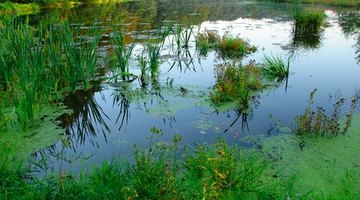How to Make a Standpipe in a Spring Pond
A standpipe is used to control the level of water in ponds. It serves as an adjustable drain, allowing the pond owner or manager to drain any water above a controllable level. By adding a sleeve---a larger pipe capped at the top end that fits over the standpipe---you can drain water from the bottom of the pond. Water will enter the assembly between the sleeve and the standpipe at the bottom and rise to the opening of the standpipe. When properly constructed, the standpipe can serve as an important management tool for a small pond.

-
Install a drainpipe from the deepest portion of the pond to the drainage area. Size the pipe to allow the pond to drain in an appropriate time. A small pond can drain in a day or two with a 4 inch pipe. Larger ponds can use pipes as large as 1 foot in diameter. Keep in mind that a large pipe may flood the drainage area. Spring fed ponds---ponds with natural flowing underground water sources---are continuously replenished and may require larger drainage pipes.
-
Attach a 90 degree swivel fitting to the end of the drainpipe. Depending on the amount of mud in the bottom of the pond, it may be advisable to attach this fitting before placing the drainpipe. The swivel function of this fitting allows control of the water levels that will be drained.
-
Attach the standpipe to the swivel fitting. The standpipe, when standing straight up, should be at least as high as the high water capacity of the pond. As the standpipe is pivoted on the swivel fitting, the top of the pipe drops to lower levels, allowing the pond to be drained to any desired level. Attach a rope or chain system to the standpipe to allow control of the standpipe position. Make sure this is secure; if the standpipe inadvertently falls down, the entire pond will drain.
-
Optionally, fit a sleeve over the top of the standpipe. A sleeve is simply a pipe with a diameter larger than the standpipe that is capped at the top end. Water enters the standpipe assembly at the bottom between the standpipe and the sleeve and is forced up by water pressure then flows through the standpipe. This allows removal of water from the bottom of the pond, which is usually of poorer quality than water near the surface, and is useful when you are only partially draining the pond
Tips
- A properly placed standpipe sets the maximum depth for the pond. In spring fed ponds, water may continuously drain through the standpipe. If you use a sleeve on the standpipe, the water will be removed from the bottom of the pond.
Writer Bio
Keith Allen, a 1979 graduate of Valley City State College, has worked at a variety of jobs including computer operator, medical clinic manager, radio talk show host and potato sorter. For over five years he has worked as a newspaper reporter and historic researcher. His works have appeared in regional newspapers in North Dakota and in "North Dakota Horizons" and "Cowboys and Indians" magazines.
Photo Credits
- pond image by Tomasz Kubis from Fotolia.com
More Articles



